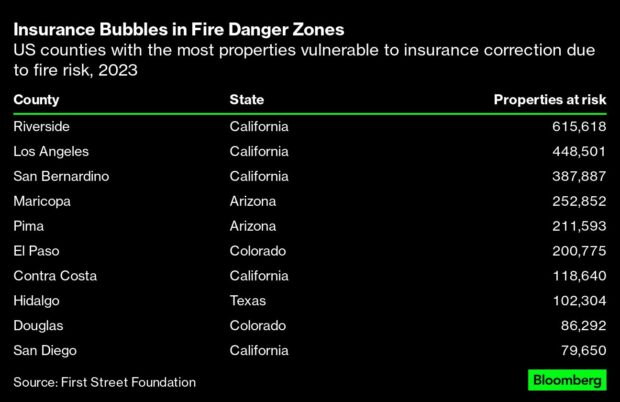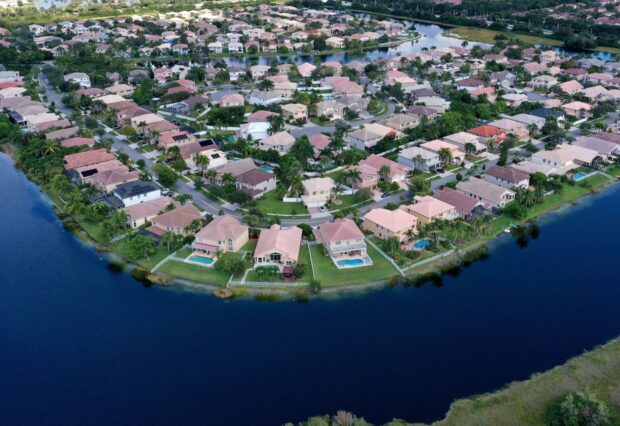Home insurance costs that have soared in much of the U.S. may get even higher.
Tens of millions of properties around the country are insured at prices that haven’t caught up with the danger of hurricanes, wildfires and floods, according to a new report from the First Street Foundation, a nonprofit that works to define and communicate risks posed by climate change.
First Street estimates that 39 million U.S. homes are insured at artificially suppressed prices compared with the risk they actually face. Of those, nearly 6.8 million homes are covered by state-backed “insurer of last resort” policies.
Until now, state regulations that cap increases in insurance premiums and subsidized insurer-of-last-resort programs have hidden the magnitude of the problem, the report’s authors say. But as the number of disasters and the related damages keep rising, they predict, the insurance market will undergo a major adjustment and rates will surge, popping what the nonprofit calls a climate insurance bubble.

“The overreliance of property owners on the state-run insurers of last resort is a big flashing sign that standard practices in the insurance market cannot keep up with our current climate reality,” said Matthew Eby, First Street’s executive director.
Eby said that when the market correction happens, it will render millions of homes essentially uninsurable and therefore cause their value to drop.
At the core of the problem is an increase in the severity of disasters exacerbated by climate change and the damage they wreak. Take wildfires: Despite huge increases in federal government spending to contain breakouts, the U.S. acreage burned has gone up steadily and the average number of structures destroyed by these blazes each year since 2009 has more than tripled to over 17,000.
Wildfire risk is particularly bad in California, but insurance prices there are heavily regulated. So if a home that had a premium of $2,000 in 2010 saw it go up 7 percent a year — the most allowed under state law without a public hearing — the owners would have paid about $4,820 by 2022. But that is about $3,000 less than what would be actuarially sound, First Street says.
That explains in part why major insurers like State Farm General Insurance Co. and Allstate Corp. are reducing their exposure to the state by not issuing new policies and in some cases declining to renew existing ones.

And it’s not just California. Farmers Insurance Group said in July it would stop writing new policies in Florida, joining more than a dozen other insurers. Florida’s publicly backed insurer of last resort, Citizens Property Insurance Corp., is now the state’s largest. In Louisiana, many insurers were declared insolvent and rates jumped 18.5 percent on average in 2022.
High-risk U.S. ZIP codes have seen a significant increase in non-renewals — most of all in San Bernardino County, Calif., where one ZIP code experienced a 774 percent increase in non-renewals between 2015 and 2021. Not coincidentally, the state’s insurance plan of last resort added one-third more policies over the same period.
The average U.S. homeowner who receives a insurance non-renewal notice automatically loses a double-digit percentage of the home’s value, according to First Street.
While homeowners in California’s wildland urban interface are seeing big increases now, that foreshadows what millions of other property owners elsewhere will soon face, the report says. Since 2021, for example, the Federal Emergency Management Agency, which oversees the National Flood Insurance Program, has been rolling out new rates that are supposed to reflect the real flood price of flood risk that until now has been heavily subsidized.
That has meant increases in prices for most people in the program. And the adjustments can continue at the rate of 18 percent a year, up to a cap of $12,000.
First Street’s figure of 39 million homes vulnerable to insurance correction is based on its own property-by property analysis of risks of fire and flood. The group has previously estimated, for example, that the high-risk flood zones determined by the U.S. government exclude about 6 million homes that should be included.
The researchers acknowledge a significant margin of error for their calculations — about 20 percent. But even on their lower estimates, 30 million homes could currently be underpaying for insurance. Which means a very big, very expensive bill coming due for the nation soon.
Top photograph: In this aerial view, single family homes are shown in a residential neighborhood on Oct. 27, 2022 in Miramar, Fla. (Photo by Joe Raedle/Getty Images)





















 Odometer Fraud Sees 14% Jump in the Past Year
Odometer Fraud Sees 14% Jump in the Past Year  AI in Property/Casualty Insurance: Why Trusted Data Is the Missing Link
AI in Property/Casualty Insurance: Why Trusted Data Is the Missing Link  The Hardest Part of Innovation in Insurance Isn’t Technology; It’s Culture
The Hardest Part of Innovation in Insurance Isn’t Technology; It’s Culture  Rebuilding Negotiation Talent: Why This Skill Is Missing and How to Fix It
Rebuilding Negotiation Talent: Why This Skill Is Missing and How to Fix It 



